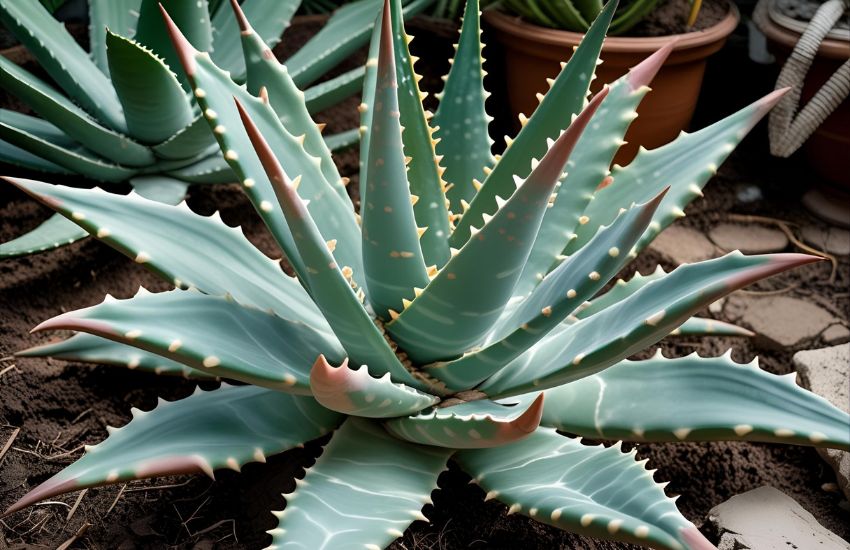If you’re searching for a resilient, eye-catching plant to brighten your space, the Aloe Juvenna, also known as Tiger Tooth Aloe, offers both charm and easy maintenance. Native to Kenya, this compact succulent belongs to the aloe genus and features spiky green leaves with toothed edges, forming a unique rosette shape. Unlike a typical cactus, Aloe Juvenna thrives with minimal water, making it perfect for busy lifestyles or beginners looking to expand their indoor cactus and succulent collection.
Aloe Juvenna, also known as Tiger Tooth Aloe, thrives in direct sunlight and well-drained soil. Its spiky, green leaves with marginal teeth turn reddish to brown tones in spring and summer. Rare in the wild, this compact succulent adds charm to any collection. Embrace Aloe’s beauty by watering sparingly and avoiding frost exposure.
In this guide, you’ll learn how to care for your Tiger Tooth Aloe, from selecting the right pot to handling pests, and even how to succeed with simple propagation methods. Get ready to embrace the striking beauty and practicality of this hardy aloe.
Simple Propagation and Pest Solutions for Aloe Juvenna Plant Health

Maintaining the health of your Aloe Juvenna, commonly known as tiger tooth aloe, involves more than just watering and sunlight. This houseplant, native to Kenya, is known for its fleshy leaves and spiny texture. It belongs to the genus Aloe, sharing similarities with aloe squarrosa, yet standing out for its compact growth and densely packed rosettes. To help your juvenile aloe thrive, understanding effective plant care, particularly propagation and pest control, is essential.
Propagation: Multiply Your Tiger-Tooth Aloe the Smart Way
One of the simplest and most rewarding aspects of tiger tooth aloe care is propagation through offsets. This variety suckers profusely, producing small plantlets around the base. When you notice a healthy juvenile offset with several erect leaves, gently separate it from the parent using a clean, sharp knife. Allow the offset to dry for a day to callous over before planting it into a well-draining soil mix.
Choose a pot with drainage holes and use a soil mix that ensures good drainage. Avoid overwatering by letting the soil dry out completely between waterings. Place the pot in a bright area with light shade to full sun or use a grow light if kept indoors.
Pest Prevention: Shield Your Aloe from Common Issues
Even a tolerant succulent like Aloe Juvenna can face issues if neglected. Pest infestations are often indicated by white spots, curled or discolored leaves, or stunted growth. Mealybugs and spider mites are the most common threats. These pests thrive in humid conditions, especially if the plant is brought indoors without proper air circulation.
To manage infestations, wipe affected areas with alcohol-soaked cotton or use an insecticidal soap. Avoid excessive moisture and ensure your potting setup includes good drainage to minimize conditions that attract pests. Allow the soil to dry thoroughly and always water at the base—never on the fleshy leaves.
When and How to Repot for Healthier Growth
If your Aloe Juvenna becomes root-bound or the soil mix depletes nutrients, it’s time to repot. Choose a container slightly larger than the current one, with ample drainage holes. Refresh with fresh, well-draining soil and resume watering only after the roots settle. Be cautious of root rot, a common result of poor drainage or overwatering.
Conclusion
Caring for your Aloe Juvenna is a rewarding journey that offers beauty, structure, and low-maintenance appeal to any indoor garden. With its tight rosette, spiny marginal teeth, and striking reddish to brown tones, especially under direct sunlight or strong bright light, this rare in the wild succulent stands out as a bold decorative piece. Ensuring proper plant care with the right conditions—like well-drained soil enhanced with perlite, and a watering habit where you water deeply and allow the soil to fully drain—helps your plant tolerate various environments and truly thrive.
When propagating, always use a sharp knife and wait for the right season, preferably during spring and summer, for successful results. Whether you’re managing pests, refreshing the soil, or enhancing light exposure with LED grow lights or natural indirect light, every step you take contributes to a healthier, more vibrant plant. Look out for spots on inner leaves or reddish-brown discoloration as signs of stress, especially during the winter months, when your care routine may need adjustment.
Ready to grow a thriving tiger tooth aloe collection? Start today with proper tools, hours of sunlight, and a commitment to learning—your Aloe Juvenna will thank you.
